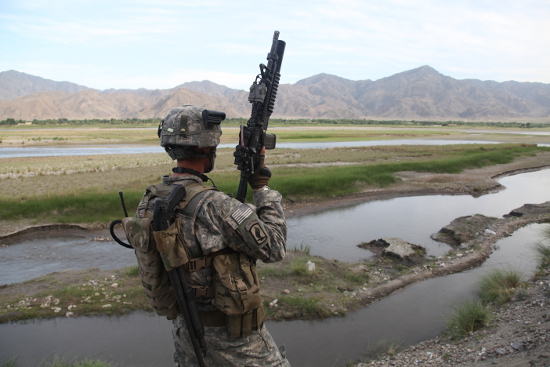
US Army Sergeant David M. Pooler, of 1st Platoon, Able Company, 2nd Battalion, 503rd Infantry Regiment, 173rd Airborne Brigade Combat Team, scans the area across the Kunar River as he provides security in the Noorgal district of Kunar province, Afghanistan, May 1, 2010 as part of a community development council meeting. US Army photo by Specialist Lorenzo Ware.
Below is ISAF’s official press release on the withdrawal from the Pech Valley in Kunar province:
Coalition forces are repositioning from the Pech Valley to locations along Highway 7 to block insurgent infiltration along the Afghanistan-Pakistan border.
“Afghan forces will take the lead in the Pech Valley,” said German Army Gen. Josef Blotz, spokesman, International Security Assistance Force Headquarters, in Kabul, Afghanistan, Monday, during a weekly update.
Repositioning forces is a normal task for military operations as new strategies and counter-strategies are enacted to win the war. The repositioning of coalition forces also shows an increase in the abilities of Afghan National Security Forces.
“Afghan Security Forces are able to take responsibility of Pech Valley,” Blotz continued. “This is testimony to our confidence.” Blotz highlighted that while the numbers of ANSF have increased, their skill and abilities have also improved.
The news of this repositioning came as Dominic Medley, senior civilian representative spokesman, NATO, discussed the upcoming transition of the responsibility of security to the Afghan government.
The Joint Afghan NATO Inteqal [Transition] Board met on Tuesday to provide recommendations to Afghanistan’s President Karzai and NATO’s North Atlantic Council, said Medley.
“We fully expect, as President Karzai has announced his intention, that on the 21st of March he will announce – as president of this country – where transition will begin,” said Medley.
The transition board was chaired by Dr. Ashraf Ghani Ahmadzai, chairman, Afghan Transition Coordination Commission, and co-chaired by Gen. David Petraeus, commander, ISAF/U.S. Forces-Afghanistan, and Ambassador Mark Sedwill, NATO Senior Civilian Representative to Afghanistan.
ISAF clearly is banking on Afghan forces to secure the Pech Valley. However, this didn’t work so well in the district of Barg-e-Matal in Nuristan province, which was overrun by Taliban forces several times last summer once Afghan soldiers and police were put in charge of security. With Taliban sanctuaries directly across the border in the Pakistani tribal agencies of Bajaur and Mohmand, and existing Taliban and al Qaeda safe havens within Kunar, Afghan troops will be hard pressed to hold the bases in the Pech, even with US air support. See Threat Matrix report US begins withdrawing forces from Kunar’s Pech Valley for more commentary on this issue.
Are you a dedicated reader of FDD's Long War Journal? Has our research benefitted you or your team over the years? Support our independent reporting and analysis today by considering a one-time or monthly donation. Thanks for reading! You can make a tax-deductible donation here.








2 Comments
Hopefully the ANSF is up to the task.
That was a Masterpiece of modern public relations spin. Too funny to even laugh at. However, I am recently starting to come to the same possible conclusion : Abandon the hinterlands for the Afghans to figure out and just hunker down in defensible enclaves/bases, protect Kabul and strike out only at Al Quedas and Taliban HVTs when possible.